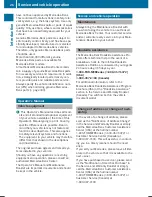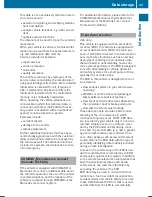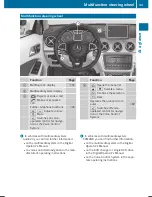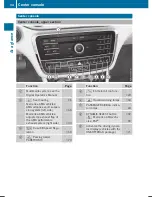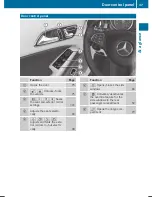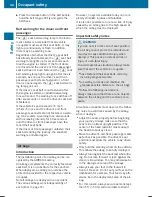
Panic alarm
X
To activate: press and hold the
!
button
:
for approx. one second.
A visual and audible alarm is triggered if the
alarm system is armed.
X
To deactivate: press
!
button
:
again.
or
X
Insert the SmartKey into the ignition lock.
or, in vehicles with KEYLESS-GO start-function
or KEYLESS
‑
GO
X
Press the Start/Stop button.
The SmartKey must be in the vehicle.
Occupant safety
Introduction to the restraint system
The restraint system can reduce the risk of
vehicle occupants coming into contact with
parts of the vehicle's interior in the event of an
accident. The restraint system can also reduce
the forces to which vehicle occupants are sub-
jected during an accident.
The restraint system includes the following
components:
R
seat belt system
R
air bags
R
child restraint system
R
child seat securing systems
The components of the restraint system work
in conjunction with each other. They can only
deploy their protective function if, at all times,
all vehicle occupants:
R
have fastened their seat belts correctly
(
Y
page 42)
R
have the seat and head restraint adjusted
properly (
Y
page 92)
As the driver, you also have to make sure that
the steering wheel is adjusted correctly.
Observe the information relating to the correct
driver's seat position (
Y
page 92).
You also have to make sure that an air bag can
inflate properly if deployed (
Y
page 44).
An air bag supplements a correctly worn seat
belt. As an additional safety device, the air bag
increases the level of protection for vehicle
occupants in the event of an accident. For
example, if, in the event of an accident, the
protection offered by the seat belt is sufficient,
the air bags are not deployed. When an acci-
dent occurs, only the air bags that increase
protection in that particular accident situation
are deployed. However, seat belts and air bags
generally do not protect against objects pene-
trating the vehicle from the outside.
Information on restraint system operation can
be found under "Triggering of the Emergency
Tensioning Devices and air bags"
(
Y
page 51).
See "Children in the vehicle" for information
on children traveling with you in the vehicle as
well as on child restraint systems
(
Y
page 53).
Important safety notes
G
WARNING
Modifications to the restraint system may
cause it to no longer work as intended. The
restraint system may then not perform its
intended protective function and may fail in
an accident or trigger unexpectedly, for
example. This poses an increased risk of
injury or even fatal injury.
Never modify parts of the restraint system.
Never tamper with the wiring, the electronic
components or their software.
Occupant safety
39
Safety
Z


